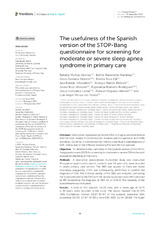Mostrar el registro sencillo del ítem
The usefulness of the Spanish version of the STOP-Bang questionnaire for screening for moderate or severe sleep apnea syndrome in primary care
| dc.contributor.author | Muñoz Gómez, Rafaela | |
| dc.contributor.author | Navarrete-Martínez, Esther | |
| dc.contributor.author | Serrano Merino, Jesús | |
| dc.contributor.author | Silva Gil, Fátima | |
| dc.contributor.author | Roldán-Villalobos, Ana María | |
| dc.contributor.author | Martín Rioboó, Enrique | |
| dc.contributor.author | Ruiz-Moruno, Javier | |
| dc.contributor.author | Romero Rodríguez, Esperanza María | |
| dc.contributor.author | González-Lama, Jesús | |
| dc.contributor.author | Vaquero Abellán, Manuel | |
| dc.contributor.author | Perula-de Torres, Luis Ángel | |
| dc.date.accessioned | 2024-01-10T15:54:43Z | |
| dc.date.available | 2024-01-10T15:54:43Z | |
| dc.date.issued | 2022 | |
| dc.identifier.uri | http://hdl.handle.net/10396/26487 | |
| dc.description.abstract | Rationale: Sleep apnea-hypopnea syndrome (OSA) is a highly prevalent disease and has been related to cardiovascular diseases and occupational and traffic accidents. Currently, it is estimated that there is a significant underdiagnosis of OSA, mainly due to the difficulty accessing the tests for that purpose. Objective: To determine the usefulness of the Spanish version of the STOP-Bang questionnaire (SBQ) for screening for moderate or severe OSA in the adult population attending primary care. Methods: A descriptive observational multicenter study was conducted. Through an opportunistic search, (patients over 18 years old), were recruited in seven primary care centers. The SBQ was applied to them and home respiratory polygraphy (HRP) was subsequently performed to confirm the diagnosis of OSA. The criterion validity of the SBQ was analyzed, comparing the score obtained by the SBQ with the apnea-hypopnea index (AHI) obtained by RP, establishing the diagnosis of OSA for an AHI>5. The reliability of the questionnaire was evaluated. Results: A total of 255 subjects, 54.1% men, with a mean age of 54.76 ± 10 years, were recruited in the study. The results showed that 61.57% (95% Confidence Interval: 55.57–67.57) of the subjects presented OSA, presenting 22.75% (17.57–57.92) a mild OSA (530) (11.54–20.62). The Kuder and Richardson coefficient was 0.623 (0.335–0.788) and Cohen's Kappa coefficient was 0.871 (0.520–1.00; p < 0.001). For moderate/severe OSA screening (AHI>15) the SBQ obtained an ROC curve of 0.769 (0.704–0.833) that with an optimal cutoff of 3, achieved a sensitivity of 84.85% (77.28–92.42) and a specificity of 55.10% (44.74–65.46). Conclusions: The SBQ is very effective for detecting moderate/severe OSA. Its psychometric properties are similar to those obtained in studies on other populations. Because of its ease of use, the SBQ is a very useful tool for primary health care professionals. | es_ES |
| dc.format.mimetype | application/pdf | es_ES |
| dc.language.iso | eng | es_ES |
| dc.publisher | Frontiers | |
| dc.rights | https://creativecommons.org/licenses/by/4.0/ | es_ES |
| dc.source | Muñoz-Gómez, R., Navarrete-Martínez, E., Serrano-Merino, J., Silva-Gil, F., Roldán-Villalobos, A., Martín-Rioboó, E., Ruiz-Moruno, J., Romero‐Rodríguez, E., Gonzalez-Lama, J., Vaquero-Abellán, M., & Perula-De-Torres, L. A. (2022). The usefulness of the Spanish version of the STOP-Bang questionnaire for screening for moderate or severe sleep apnea syndrome in primary care. Frontiers in Public Health, 10. https://doi.org/10.3389/fpubh.2022.975114 | es_ES |
| dc.subject | Primary care | es_ES |
| dc.subject | Obstructive sleep apnea syndrome | es_ES |
| dc.subject | STOP-Bang questionnaire | es_ES |
| dc.subject | Home respiratory polygraphy | es_ES |
| dc.subject | Berlín questionnaire | es_ES |
| dc.title | The usefulness of the Spanish version of the STOP-Bang questionnaire for screening for moderate or severe sleep apnea syndrome in primary care | es_ES |
| dc.type | info:eu-repo/semantics/article | es_ES |
| dc.relation.publisherversion | https://doi.org/10.3389/fpubh.2022.975114 | es_ES |
| dc.relation.projectID | Junta de Andalucía. AP-0177-2018 | es_ES |
| dc.rights.accessRights | info:eu-repo/semantics/openAccess | es_ES |

